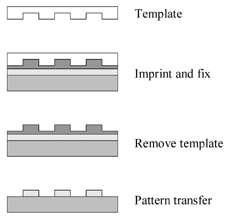A nonprojection lithographic technology, imprint lithography, has recently been introduced.1 Imprint lithography is essentially a micromolding process, shown schematically in Fig. 12.23. First, a template of the pattern is created. This consists of recessed areas on a piece of a hard substance that will eventually correspond to portions of the wafer where material will remain after etch. In one form of this technology, step-and-flash imprint lithography (SFIL),2 the template is formed from glass. It is formed from nickel or silicon in another form called nano-imprint lithography (NIL).3

To create patterns on the wafer, a small puddle of liquid is dispensed on the wafer, and the template is pressed against the liquid to “imprint” the pattern. After imprinting, the pattern is then fixed on the wafer. With SFIL, the resist material is solidified by exposure with ultraviolet light, while heat and pressure are used with the NIL version of imprint lithography. The template is then released, and the substrate can then be etched.
With this technology, extremely high-resolution lithography has been achieved. Not only have 20-nm features been produced but small fabrication errors in the template of just a few nanometers in size have been replicated. (Fig. 12.24) This technology clearly has high-resolution capability.

Imprint lithography has some definite advantages and disadvantages.4 Because there is no high-resolution lens required, imprint patterning tools are expected to be considerably cheaper than high-performance step-and-scan exposure tools. Offsetting this advantage is the 1× nature of the template, and difficulties similar to those experienced with x-ray masks might be expected. However, there are some aspects of template fabrication for imprint lithography that make them easier to produce than x-ray masks. In particular, it was necessary to fabricate x-ray masks on thin membranes, which made registration control very difficult. In contast, imprint templates are formed on rigid glass substrates. Even on glass substrates, the 1× nature of the templates represents a formidible challenge.
Imprint lithography is a contact patterning method. Projection optical lithography was developed as a replacement for optical contact printing, because defect levels were too high with contact printing to support high levels of integration. It remains to be seen if yield problems will not be prohibitive with imprint lithography.
References
- D.J. Resnick, W.J. Dauksher, D. Mancini, K.J. Nordquist, T.C. Bailey, S. Johnson, N. Stacey, J.G. Ekerdt, C.G. WIllson, S.V. Sreenivasan, and N. Schumaker, “Imprint lithography: lab curiosity or the real NGL?” Proc. SPIE 5037, pp. 12–23 (2003).
- M. Colburn, S. Johnson, M. Stewart, S. Damle, T. Bailey, B. Choi, M. Wedlake, T. Michaelson, S.V. Sreenivasan, J. Ekerdt, and C.G. Willson, “Step and flash imprint lithography: a new approach to high-resolution printing,” Proc. SPIE 3676, pp. 379–389 (1999).
- S.Y. Chou, P.R. Krauss, P.J. Renstrom, “Nanoimprint lithography,” J. Vac. Sci. Technol. B 14(6), pp. 4129 – 4133 (1996).
- D.J. Resnick, W.J. Dauksher, D. Mancini, K.J. Nordquist, T.C. Bailey, S. Johnson, N. Stacey, J.G. Ekerdt, C.G. Willson, S.V. Sreenivsasan, and N. Schumaker, “Imprint lithography for integrated circuit fabrication,” J. Vac. Sci. Technol. B 21(6), pp. 2624–2631 (2003).
- D.J. Resnick, W.J. Dauksher, D. Mancini, K.J. Nordquist, E. Ainely, K. Gehoski, J.H. Baker, T.C. Bailey, B.J. Choi, S. Johnson, S.V. Sreenivsasan, J.G. Ekerdt, and C.G. Willson, “High-resolution templates for step and flash imprint lithography,” Proc. SPIE 4688, pp. 205–213 (2002).
H. J. Levinson, Principles of Lithography, Second Edition, SPIE Press, Bellingham, WA (2005).
View SPIE terms of use.
